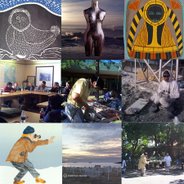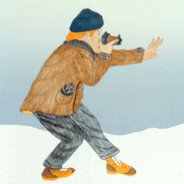 I had just spent three weeks in Iqaluit, Nunavut getting this academic year's courses underway. Within a few days of my return to the Ottawa area the youth suicide epidemic struck again. I wrote this letter to cyberspace but I really did not expect any response.
I had just spent three weeks in Iqaluit, Nunavut getting this academic year's courses underway. Within a few days of my return to the Ottawa area the youth suicide epidemic struck again. I wrote this letter to cyberspace but I really did not expect any response. To: The Editor of the New York Times
To: The Editor of the Nunatsiak News
The fireplace is casting a blanket of warmth through our cottage home but I still feel chilled. The small lake is as clear as a mirror today, leaves reflected in and floating on the surface burn with rich colours but I can’t really enjoy them today.
Yesterday my urban Inuit students in their course on Inuit art, spoke of death --- too many deaths, too many funerals and fresh graves in small communities where almost no one is left untouched. Another youth, Jimmy took his life last weekend in Iqaluit, Nunavut. The suicide rate in North America’s far north has no equal anywhere on our globe. We couldn't just talk about sculpture, prints and drawings. I strained to hear not just to listen . . . to force time to slow down. I was out of sync with the cadence of their voices. These are supposed to be the learners but I am learning from them. They were grappling with the loss of someone who was a real embodied presence throughout their youth and childhood. I needed them to help me understand. I speak too fast with too many words.
Seventeen hours later after trying to watch brain candy or tranquilize my mind with the hues and saturations of the lake leaves, I am still unable to settle in to my real world obligations. So I am writing letters to cyberspace addressing them to journalists. We are connected. NYT journalists do not simply produce our news stories, they construct our communal archives. The political philosophies that appear in the Times columns inform conversations internationally. Decisions made, policies enacted, interventions, transactions and agreements undertaken in New York, California, Washington, Kyoto, Rio Janeiro, The Hague, Tel Aviv, Baghdad, Beijing, Winnipeg, Ottawa and Toronto have as much --- if not more --- impact than conversations and consultations held in Nunavut. Assumptions and debates about the market, big or small government, direct democracy, policing, racial profiling, drugs, welfare, poverty, taxes that are covered in the pages of the New York Times impact far beyond the space on the grid of a New York mile and the time contained in a New York minute.
This is not Jimmy’s story. Inuit have tried hard to teach me that I cannot tell their stories. I can only tell my story through my eyes and my experience. Jimmy used to live in Iqaluit, Nunavut. He had a good construction job and his friends knew him as a young man who had a lot to live for.
Construction in Nunavut is booming. Entrepreneurs come north for several years or decades and legally amass fortunes as they rush ahead to improve southern Canada’s GNP by building, renting and leasing northern dwellings at prices several times the cost of a similar dwelling in the south. This is a boon to government workers and the upper middle class both Inuit and non-Inuit. According to the logic of the marketplace, this will eventually trickle down to the Inuit who are the most disadvantaged in the North in regards to underemployment, access to education, health and housing. But the youth are dying so quickly I don’t know how many will be there to benefit when help finally does arrive. In the midst of this construction boom many Inuit are still living in overcrowding conditions shockingly comparable to the Third World. Nunavut is a conflicted region of great promise after negotiating a more equitable relationship to the rest of Canada but it is also a region of ever-deepening despair. Extremes of wealth and poverty co-exist with intimacy that is too close for comfort.
Last week Jimmy was part of the boom. He was one of the fortunate Inuit who had found a job. The friends who introduced me to Jimmy through their memories of him, described a young man full of promise. The cadence of the conversations yesterday, like many kitchen table conversations with First Nations, Inuit and Metis friends resonates with the dialogue and silences that narrate the ‘long take’ vistas of a Zach Kunuk video. One of the students from the Igloolik area --- where Atanarjuat was filmed --- spent yesterday afternoon tracing intricate trails in red on a university photocopy of a 1-125,000 map of the islands, waterways and mainland that he knew intimately from his years of traveling with his grandfather. As he traced the pathways, he meticulously wrote the names of familiar places in red syllabics. From time to time he would explain the meaning of these coded words. Each place name described the physical space so accurately it was as though he succeeded in breaking the code that unlocked Borges’ ‘Art of Cartography.’ As he spoke, Julia whispered warnings about imposed flag post place names like Fury Strait. He created a virtual image for me --- and anyone else in the room who strained to listen. The images, sounds and smells he evoked were themselves Hauntings. As he traced and retraced these red pathways that barely covered inches on the photocopied map --- I, the cyborg collector of digital archives, could take a Janet Cardiff’s Wanås Walk… three-hour hikes… seven-hour hikes to his favourite places… seeing panoramas vicariously through his eyes… hearing silence and the wind, tasting… smelling. The place names acknowledged the super natural market of food supplies available to travelers who had local knowledge. He indicated and word painted the tiny island called Tern Island where his father was born.
He fingered the miniscule unmarked place on the map haunted by the toxicity of the abandoned Dew Line site that is socially, historically, politically, emotionally and physically charged. These stories of these sites, like the stories of the many suicide martyrs, have been erased from communal memory. But the threat of their toxins is a constant reminder of the fragility of the micro ecosystem of this unique place.
The island of Igloolik --- the place of many dwellings --- is where the family of my guide on my vicarious journey, returned for generations. Centuries of overlapping circular trails could be traced on this map in sharp contrast to the grid-like pattern of modernity cut into a New York mile of urban architectural spaces. The layered trails would represent countless seasonal journeys from hunting camp to fishing camp traveling on foot, by dogsled, kayak, Peterhead, snow machine or by foot. Like so many isolated places in the North --- Igloolik --- has been inhabited by the semi-nomadic Inuit for centuries if not millennia. Travelers walking on the land still come across centuries-old natural museums, archives and caches that should have been forgotten. Because the archives are not written, there is an assumption that they do not exist. But the tundra itself has written the story of the early travelers in vivid colours on ancient abandoned sites. Tiny resistant plants that flourished on organic accumulative remains unlock the entrance to the site of ancient bones and tusks. Discarded objects and ancient bones tell stories of those who traveled before.
How far can you go in a New York minute? How many miles are encompassed in the Wall Street grid? How much widescreen and close-up geography can be covered in the longue duree, the ‘long take’, the extended view that echoes natural time. Jimmy’s identity was a personal geography he inhabited, composed of endlessly repeated everyday habits haunted by a communal history that resists the forced act of forgetting.
This week Jimmy’s life and story is beginning a process of being wiped out, completely erased, deleted from communal memory. In an everyday life process his image is beginning already to move from opacity to transparency in the painful but unspoken process of total erasure from a community’s memory. Once the local memory is completely gone, the tiny byte of time and place that he once occupied will be irretrievable from the meta files of data being processed in this the age of the great flood of the archives. If he had children they will never know their father’s story. His image will not be found in photo albums nor will laughter at his exploits be shared around kitchen tables. His name --- if it ever does come up again --- will be spoken only in whispers. Jimmy is not being cruelly punished for dying young. His memory, his life is doubly and triply erased in a desperate attempt to save the youth around him. In Iqaluit, Nunavut there is still nowhere for those youth-at-risk to go for help. They are living and dying through the worst epidemic of suicide on the planet.
When my granddaughters are reading the socio-economic, cultural and political histories of North America several decades from now, how will the story be told? How can and will the bones of this entire generation of our youth be explained and justified? These are our youth. They are not Canadian or American. They are North American.
Maureen Flynn-Burhoe
October, 2003
Bell Lake, Quebec, Canada
I had just returned from Iqaluit, Nunavut where I had set up two courses. I had developed a northern-centred course on Human Rights that was I was teaching along with the Introduction to Sociology I had taught from January to June in 2002. I didn't really want to return to Nunavut but the Director and administrators of the Centre for Initiatives in Education really wanted me to go again. Last term was such a success they had signed an agreement with Nunavut Arctic College President, McClenning. But the Inuit Art Foundation in Ottawa wanted me to teach their courses again as well. So I was commuting between Iqaluit and Ottawa. My own PhD was moving too slowly.
Email correspondence in response to letter
Date: Fri, 24 Oct 2003 16:01:08 -0400
Subject: Re: An Epidemic of Youth Suicide
To: Maureen Flynn-Burhoe
From a friend and mother who works in education in Iqaluit, Nunavut
Thank you for your for sensitive insights and for taking action. Your letter is very eloquent and persuasive. I am at my wits end with the number of deaths as it impacts so terribly on the youth left behind. I had to get my x out of town once again at the end of August after a friend died in a wasteful and tragic car accident. x stayed out visiting family and friends, then joined x and I for Thanksgiving in our x house. It was so peaceful and sane. We all returned on Sunday. The very first phone call to x was from a friend informing x of Jimmy's suicide. x had worked with Jimmy last summer at x. x just collapsed and all the healing seems for nought. Yet x went to the funeral yesterday, but today x hasn't really risen from bed. And at lunch today, I heard that x's step son (really her grand son) died last night, a possible suicide, but we won't know until the autopsy is completed. He was only 19. I think we may have to move away, just in order to keep our x healthy and optimistic about life and youth. Again, though you letter so beautifully articulated the problem. I hope they respond.
From a friend, an anthropologist in Israel working with an off-campus Social Work program for Bedouin women:
Your letter arrived just in the right time to strengthen my belief that, after all, we are connected by some sort of a great path leading us to the same places, meeting us at some crossroads. In two days I am about to start a new course named "Inter-cultural Training in Human Services". Your letter will certainly be shared with the students at the beginning of the course, used as a starting point. I thank you so much for letting me be part of your healing -I consider it as our mutual need for healing. I know from very close the feelings of self-devastation, just from hearing about the silent violence in their lives. But we need to heal ourselves so we can continue hearing the stories and expand the message as far as we can, to as many ears we can, especially to those who can make changes. The act of hearing itself is, I believe, a direct healing process, a humanizing process, we experience with the direct victims of the community, all hurt by the violence. Be strong and courageous to go on in this painful task and remember to take care of yourself. I am always here for you (despite the distance) very close to you in my thoughts and feelings. wish you all the best and warm hugs to x, x
From a university student
Your story was emotionally moving. It is truly unfortunate how there are not enough articles that try and explain the truth, that will attempt to reveal an alternate side to what is actually going on. The newspaper is a valuable source of information, however if we cannot rely on it to report factual accounts than how are we to remain informed? I find that in today’s society it is getting harder and harder to experience true reality. Organizations that are supposed to relay news to us (the individuals) such as CNN, The New York Times, The Ottawa Sun, etc… seem to always have an incredibly bias view on things. It is unfortunate that instances like these occur yet; it seems that if they were to print the truth they would have too much to lose thus, resulting in uninformed patrons, such as yourself and others like me. The account you heard about Jimmy, appears to be a common story in native life these days, and it makes me sore inside. This summer on my way to Vancouver I had the pleasure of being seated next to a lovely young girl named Suzie. She was a young lady from Coral harbor – a small island off the coast of Hudson Bay in Nunavut. As we flew I found out many interesting things about the life she lived. The way hers differed from mine was substantially significant. She told me about her life up north, how she witness first hand a good friend of hers commit suicide, she experienced her brother take his own life, and even her local high school, it seemed like there was another case of suicide every other week. She was flying back to Victoria where she attended a fashion design school. Talking to her really opened my eyes up as I am sure your students opened yours. It was wonderful to see how far she had come along; taking into account the experiences she had gone through.
I believe part of the problem these youth face is the way in which society “has” regarded them. In the past native people have always been looked down upon and have been pushed around physically and mentally. There have been many repercussions created to alleviate the Native community, however many of these things have come a little too late. Obviously the argument can be made stating that these repercussions are better than nothing, yet it still doesn’t account for the losses native youth will suffer.
In order to understand what is actually going on in places such as Iqaluit there needs to be a proper healing process. Having stories printed in newspapers about those who have suffered are only the beginning of the healing process. Marilyn Manson, a famous musician was asked what he would have done to prevent the shooting that occurred at Columbine High School. He said “I wouldn’t have said anything to them; I would have listened to them, and what they had to say.” This is an attitude that should be adopted by many more school officials that deal with students and stressful environments. The youth of Iqaulit not only deserve someone to direct them in correct directions they NEED someone who is willing to listen and to understand their problems. Peter Tenute




No comments:
Post a Comment